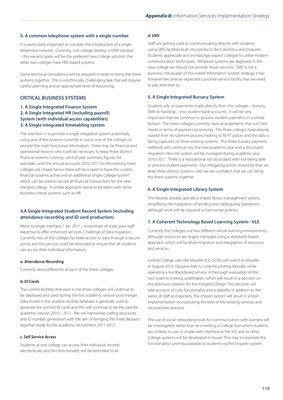
Appendix 8: Information Services Implementation Strategy
119
5. A common telephone system with a single number
It is particularly important to consider the introduction of a single
telephone network. Currently, one college deploys a VOIP solution
- this we anticipate will be the preferred new college solution, the
other two colleges have PBX based systems.
Some technical consultancy will be required in order to bring the three
systems together. This is a technically challenging task that will require
careful planning and an appropriate level of resourcing.
CRITICAL BUSINESS SYSTEMS
1. A Single Integrated Finance System
2. A Single Integrated HR (including payroll)
System (with individual access capabilities)
3. A Single integrated timetabling system
The intention is to provide a single integrated system potentially
using one of the systems currently in use in one of the colleges to
provide the main functional information. There may be i nancial and
operational reasons why it will be necessary to keep three distinct
i nancial systems running -end of year summary i gures, for
example- until the annual accounts 2010-2011 for the existing three
colleges are closed hence there will be a need to have the current
i nancial systems active and an additional 'single-college-system'
which can be used to record all i nancial transactions for the new
merged college. A similar approach needs to be taken with other
business critical systems such as HR.
4.A Single Integrated Student Record System (including
attendance recording and ID card production)
Move to single interface 1 Jan 2011 - economies of scale, pool staf
expertise to of er enhanced services. Challenge of data migration.
Currently two of the colleges facilitate access to data through a secure
portal and this service could be extended to ensure that all students
can access their individual information.
a. Attendance Recording
Currently done dif erently at each of the three colleges.
b. ID Cards
The current facilities that exist in the three colleges will continue to
be deployed and used during the i rst academic session post merger.
Data stored in the student records database is generally used to
generate the printed ID cards and this will continue to be the case for
academic session 2010 - 2011. We will harmonise coding structures
and ID number generation with the aim of bringing the three datasets
together ready for the academic recruitment 2011-2012.
c. Self Service Access
Students at one college can access their individual records
electronically and this functionality will be extended to all.
d. SMS
Staf are getting used to communicating directly with students
using SMS facilities built into products like Columbus and Enquirer.
Students appreciate and increasingly expect colleges to utilise modern
communication techniques. Whatever systems are deployed in the
new college we should not provide 'lesser services'. SMS is not a
business critical part of the overall Information System strategy it has
however become an expected customer service facility that we need
to pay attention to.
5. A Single Integrated Bursary System
Students rely on payments made directly from the colleges - bursary,
EMA or hardship - into student bank accounts. It will be very
important that we continue to process student payments in a similar
fashion. The three colleges currently have arrangements that suit their
needs in terms of payment processing. The three colleges have already
started their recruitment process looking to i ll FT places and the data is
being captured on three existing systems. The three bursary payment
methods will continue into the new academic year and a structured
migration into one system will be managed during academic year
2010-2011. There is a reputational risk associated with not being able
to process student payments. Our mitigating action should be that we
keep three distinct systems until we are coni dent that we can bring
the three systems together.
6. A Single Integrated Library System
The libraries already operate a shared library management system,
simplifying the integration of lending and cataloguing operations
although work will be required to harmonise policies.
7. A Coherent Technology Based Learning System - VLE
Currently the Colleges use two dif erent virtual learning environments,
although resources are largely managed using a standards-based
approach which will facilitate migration and integration of resources
and services.
Central College uses the Moodle VLE; GCNS will switch to Moodle
in August 2010. Glasgow Met is currently piloting Moodle, while
operating a live Blackboard service. A thorough evaluation of the
two systems is being undertaken, which will result in a decision on
the optimum solution for the merged College. This decision will
take account of cost, functionality and scalability in addition to the
views of staf and learners. The chosen system will result in a fresh
implementation incorporating the best of the existing services and
sectoral best practice.
The use of social networking tools for communication with learners will
be investigated, rather than re-inventing a College tool which students
are unlikely to use. A simple web interface to the VLE and to other
College systems will be developed in house. This may incorporate the
functionality currently available to students via the Enquirer system.